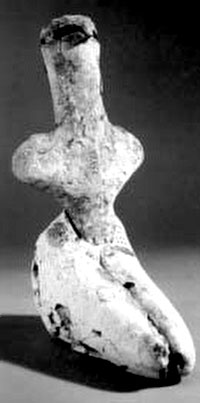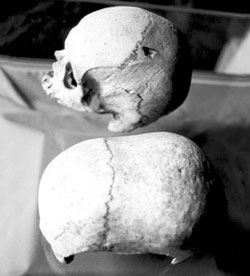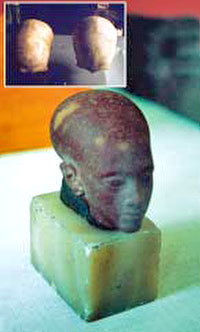|
by Vittorio Di Cesare and Adriano Forgione HERA magazine, Rome, Italy from AndrewCollins Website recovered through WayBackMachine Website
We are back from a visit in Malta among the suite of Maurizia Giusti, alias Syusy Blady and the crew of her Italian national TV show, "Tourists by Chance".
Together, we followed the traces of an ancient story that originated from the presence of megalithic temples dedicated to the Mother Goddess on the island, a thaumaturgic figure, adored in pre-historical times of this island that was to become an important cult center.
The coverage gave us the possibility to try to resolve a mystery of interesting implications. It was known that until 1985 a number of skulls, found in pre-historic Maltese temples at Taxien, Ggantja and Hal Saflienti, were exposed in the Archeological Museum of the Valletta. But since a few years ago, these were removed and placed in the deposits.
From then, they were not to be seen by the public. Only the photographs taken by the Maltese researcher Dr. Anton Mifsud and his colleague, Dr. Charles Savona Ventura, remained to testify the existence of the skulls and prove…their abnormality. Books written by the two Maltese doctors, who since our first day in Malta helpfully provided us the necessary documentation for our research, illustrate a collection of skulls that show peculiar abnormalities and/or pathologies.
Sometimes inexistent cranial knitting lines, abnormally developed temporal partitions, drilled and swollen occiputs as following recovered traumas, but above all, a strange, lengthened skull, bigger and more peculiar than the others, lacking of the median knitting.
The presence of this finding leads to a number of possible hypotheses. The similitude with other similar skulls, from Egypt to South America, the particular deformity, unique in the panorama of medical pathology referred to such distant times, (we are talking about approximately 3000 BC) could be an exceptional discovery.
Was that skull a result ancient genetic
mutation between different races that lived on that island?
The minister, whose interest in the matter we enhanced, accompanied us personally to the nearby museum, snatching the director's permission to bring out those mysterious craniums, conserved far from the sight of curious onlookers and researchers since about 15 years.
A couple of days later, in fact, guided by the museum's authorities, we were received in a reserved area, closed to public, where the extraordinary exhibits were brought, before our eyes, under the supervision and gentle accessibility of the museum's archeologist, Mark Anthony Mifsud, almost homonymous of the previous researcher.
The skulls were all found in the Hal Saflienti hypogeum, where a sacred well was dedicated to the Mother Goddess and where also the small statue of a sleeping goddess was found, associated to a relic with a snake inscription on it. The skulls were brought out of their box one at a time. Among these, all very interesting, was the one we were looking for. The cranium showed a very pronounced dolichocephalous, in other words, a lengthened posterior part of the skullcap, besides the lack of median knitting, technically named "sagitta".
This last detail has been considered "impossible" by medics and anatomists to whom we turned, not having (as far as known) analogous pathological cases in international medical literature. It is a characteristic that emphasizes the anomaly of this finding with the result of producing a natural lengthening of the cranium in the occipital area (not due to bandaging or boards as used in pre-Colombian civilizations).
We believe that the discovery of this skull and the like at
Hal Saflienti isn't accidental.
There, on both the islands, existed many sanctuaries and thaumaturgic centers, where priests surrounded the healing goddess, direct expression of her divinity. It is well known that, in antiquity, the serpent was associated to the goddess and to healing capacities.
The snake also belongs to the subterranean world. Therefore, a hypogeum dedicated to the goddess and the water cult was the right place for a sacerdotal group that was defined, in all the most ancient cultures, as the "serpent priests".
Perhaps the skulls found in the hypogeum and examined during our visit to Malta, belonged indeed to these priests. As mentioned before, they present an accentuated dolichocephalous, which is particularly the center of our analysis. The long head and drawn features must have given a serpent-like appearance, stretching the eyes and skin.
Lacking the lower part of the exhibit, we can only speculate, but the hypothesis can't be far from reality, a reality worsened buy the fact that such deformities certainly created walking problems, forcing him…to slither!
The lack of the cranium's median knitting and therefore, the impossibility of the brain's consistent, radial expansion in the skullcap, did so that it developed in the occipital zone of the cerebellum, deforming the cranium that looked like a single cap from the frontal and occipital area.
This must have certainly caused the man terrible
agony since infancy, but probably enhanced visions that were considered as
being proof of a bond with the goddess.
Some were more natural and harmonic than the cranium that mostly gained our attention, but they still presented a pronounced natural dolichocephalous and we could assume, without fear of refutation, that it is distinctive of an actual race, different to the native populations of Malta and Gozo.
This consideration was confirmed by the Maltese archeologists themselves, Anthony Buonanno and Mark Anthony Mifsud, who said:
We shall discuss this detail further on. Meanwhile, it's worth the while to emphasize that one of these skulls showed unequivocal signs of surgical intervention in the occipital area.
The outlines of three small holes, made in the occipital bone called inion, had time to cicatrize, therefore the patient survived the operation although such intervention surely would have undermined his motorial faculties. But there is more. A fair part of the 7000 skeletons dug out of the Hal Saflienti hypogeum and examined by Themistocles Zammit in 1921, present artificially performed deformations.
All the tribal apparatus of incisions, perforations, partial or total removals, cauterizations, abrasions, insertions of extraneous bodies in muscles, like the modification of bodies for magical, medical or cosmetic purposes, were part of cruel practices in such, but "with best intentions" for the community.
In Malta, all this was practiced by a mysterious populace that erected gigantic temples to the Mother Goddess between 4100 and 2500 B.C.
The presence of
these skulls might be that of the last exponents of the most ancient
sacerdotal caste that built the megalithic temples and, never having blended
with the local populations, had continued reproducing through the
millenniums within familiar unions (as was the usual practice among the
elite) and consequently impoverished its genetic patrimony until inevitable
pathologies manifested, finally disappearing.
These will begin to make Malta their Mediterranean outpost. The Phoenicians will also erect temples to the Mother Goddess in Malta, calling her Astarte, the snake-faced Goddess.
Again we
find the representation of a Goddess who is associated with the snake and
healing powers, almost as if the Phoenicians wanted to continue an
interrupted tradition. But it's the date of 2500 B.C. that presents a
fundamental key of interpretation for understanding who these long-headed
individuals were and to use it we must move from Malta to nearby
Egypt.
These presented a dolichocephalous skull, larger than that of the local ethnic group, fair hair and a taller, heavier build. Emery declared that this stock wasn't indigenous to Egypt but had performed an important sacerdotal and governmental role in this country. This race kept its distance from the common people, blending only with the aristocratic classes and the scholar associated them with the Shemsu Hor, the "disciples of Horus".
The Shemsu Hor are recognized as the dominant sacerdotal caste in pre-dynastic Egypt (until approximately 3000 B.C.), being mentioned in the Turin papyrus and the list of the kings of Abydos.
It's interesting to note that Emery writes:
Therefore, what occurred in Malta is also reflected in Egypt.
It's noticeable that in Lower Egypt, the pharaoh's symbol is a bee named "Bit". It isn't coincidental that Malta's ancient name is "Melita", which derives from the Latin word for honey. Malta's symbol was also a bee and its hexagonal cells. Melita has its origin in "Mel" or "Mer" that in Ancient Egypt was the name attributed to the pyramids.
Besides, the English term, "honey" is strictly related to the original name of Helliopolis, which is "ON". It is an interesting correlation that in Egypt, the Shemsu Hor guaranteed the respect of a solar religion and even today in Malta the sun is called "Shem-shi". "Shem" is a word of "accadic" origin, not Egyptian, deriving from the Babylonian term for the sun, that is "Shamash".
This proves that the Shemsu Hor came from the fertile half-moon area. An umpteenth correlation is the fact that this sacerdotal long-skulled caste disappeared in Egypt, as in Malta in the same period, which is between 3000 and 2500 B.C.
Who writes is convinced, although, that a third nucleus was present in the Euphrates zone, becoming part of the Arian stock known as Mithans, who the Egyptians called "Naharin", "Those of the Snake" (from Nahash, snake).
The Mithans, who occupied a part of the Kurdistan area, were Abraham's people, whose description is analogous to that of the Shemsu Hor made by Emery (fair hair and robust build). The "serpent priest" tradition originates in the Middle East, with its foremost center right in Kurdistan, where at about 5000 B.C. the matriarchal culture of Jarmo represented the mother goddesses as divinities with faces of vipers and lengthened heads.
These divinities will successively be associated to the "fallen angels" or Nephelims, that are most explicitly cited in the "Testament of Amran" in the Qumran scrolls in which is written:
It concerns, in our opinion, not divinities in the strict sense, but individuals in sacerdotal or shaman expression, belonging to a highly developed and profoundly wise culture that had relationships with lesser-organized societies of the period. Its members were considered as "half-gods" for the knowledge they possessed, just like in Egypt with the Shemsu Hor.
Analogous viper-faced statues of mother goddesses are found in the land of the Nile, dating back exactly from the archaic period of the Shemsu Hor.
It can be therefore concluded that these serpent-priests were the most ancient race that first occupied the fertile half-moon area (particularly Anatolia and Kurdistan) and Egypt (following migrations dating back 6000-4000 B.C.) until reaching Malta to disappear around 2500 B.C. but this culture survived in the Middle East and probably included one of the most famous and yet mysterious pharaohs of Egypt. It concerns the Mithans and the pharaoh Akhenaton.
The craniums of the Amarnian dynasty statues and the Malta craniums result as being practically identical, a not so fortuitous fact, also proved by the X-rays of Tuthankamon's skull, Akhenaton's son, which showed a dolichocephalous cranium.
Substantially, the Maltese craniums are the relics, archeologically still not understood; of a sacerdotal race that, in Egypt and Malta, from archaic ages, survived till 2500 B.C. It's the group that created the religious and spiritual sub-strata that characterized the greatest civilizations of the Old World, from long ago (600 B.C. or even earlier).
This group continued in the Middle East and somehow returned in Egypt around 1351 B.C. giving birth, through the heretic pharaoh Akhenaton, to a religious reform that aimed to restore the ancient order.
And if the
hypothesis that this pharaoh was linked someway to the figure of Moses is
accepted, then the rest is history.
Thirty-five pre-historic temples distributed on the two major islands, Malta and Gozo and many others actually submerged by the sea, make one think of a catastrophe that must have happened here around 3000-2500 B.C., something that left its sign.
Steep reefs falling vertically to the sea, contrarily to the more sloping northern shore, form the southern coast of Malta, the Dingli Cliffs. It's as if the island's major axis rotated around itself, submerging most of the coast that faces Sicily.
Some local archeologists, including the already mentioned Dr. Anton Mifsud and Dr. Charles Savona Ventura, consider this cataclysm to be the real cause of the Atlantis legend's birth, the history of which would re-emerge from a number of relics of the island's mysterious megalithic past. The population that created extraordinary structures of giant stones, at a certain point of the island's history, just disappeared. Two-hundred-and-fifty years of darkness actually characterize the story of these people until the arrival of the new populations that successively occupied Malta.
What had determined such an immense catastrophe?
Perhaps an earthquake or the subsiding of the calcareous platform on which Malta stands. However, we know from the Leningrad Papyrus, (a hieratic scroll dated 1115 B.C. conserved at the Hermitage museum) an Egyptian document composed around 2000 B.C., dating back to the XII dynasty, that a serpent populace was destroyed by a "star falling from the heavens". Only one survived on an island "destined to be completely submerged".
What is this strange fable? Was it the record of a catastrophe that destroyed a particular Mediterranean region?
The myth also connected the serpents to the figures of Mother Goddesses such as Tanit, Innanna, Isis and Eve. They are feminine divinities that carry the baton of a culture to which the snake brings wisdom, medical, scientific and esoteric knowledge. But a doubt arises: couldn't these serpents rather be human beings of strange physical form, perhaps even a handicap?
Mythology is full of weird beings that often seem more likely clinical cases than true divinities. For example, Cecrops, the mythical founder and first king of Athens, according to tradition, was born from the soil and his appearance was half human and half serpent.
According to others, he came to Attica from Egypt and built the Acropolis, diffusing the cult of Zeus and Athena. Pythia (or Python) was a priestess of Delphi, taken by Apollo, who pronounced oracles. She took her name from Python the snake, killed by Apollo and believed to be buried under her temple. The woman enunciated the verdicts sitting on a sacred tripod set on the mouth of a natural gorge, from which vapors exhaled and communicated them to an assistant priest (said prophet), whom in turn transmitted them to the postulant. But let's go back to Malta.
Even Saint Paul shipwrecked in the Maltese bay that still bears his name, dealing with a snake that bit his foot. In reality, in the days of Saint Paul, the first century A.D., these animals didn't exist in Malta. So it's strange that such a reptile bit indeed this Holy man. This legend may well be interpreted in a different, simpler manner.
The serpent was the last
priest of the Great Goddess left on the island, whose thaumaturgic power was
threatened by that of Paul, obliged to dismantle what was left of the last
pagan bastion of the great Healing Goddess.
|

 Malta and
Gozo were very important centers since pre-historic times, places
where "medical cures" were conducted, oracles and ritual encounters with the
priests of the goddess.
Malta and
Gozo were very important centers since pre-historic times, places
where "medical cures" were conducted, oracles and ritual encounters with the
priests of the goddess.
 A skeleton of the group that was unburied by the
archeologist, Brochtorff Circle, shows clear signs of intentional
deformation through bondage. These deformations occurred for various
reasons: initiations, matrimonies, solar rituals or punishments for social
crimes or transgressions.
A skeleton of the group that was unburied by the
archeologist, Brochtorff Circle, shows clear signs of intentional
deformation through bondage. These deformations occurred for various
reasons: initiations, matrimonies, solar rituals or punishments for social
crimes or transgressions.
 The reason why
Akhenaton was linked to
the Mithans will be the subject of a following article but the way he was
portrayed in his statues and bas-reliefs (and with him, the whole royal
family) is indeed that of an individual of lengthened head and human face
but with serpent-likeness, characteristics found in the pre-dynastic
Egyptian stock mentioned by Emery, besides being the exact representation of
the features of the Nephelims and probably the long-skulled individuals of
Malta.
The reason why
Akhenaton was linked to
the Mithans will be the subject of a following article but the way he was
portrayed in his statues and bas-reliefs (and with him, the whole royal
family) is indeed that of an individual of lengthened head and human face
but with serpent-likeness, characteristics found in the pre-dynastic
Egyptian stock mentioned by Emery, besides being the exact representation of
the features of the Nephelims and probably the long-skulled individuals of
Malta.